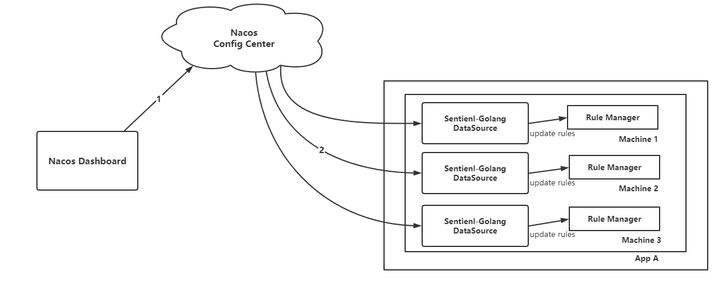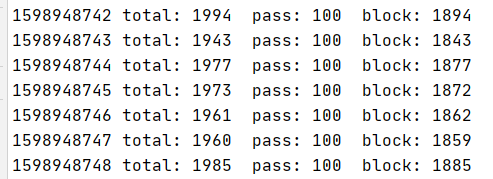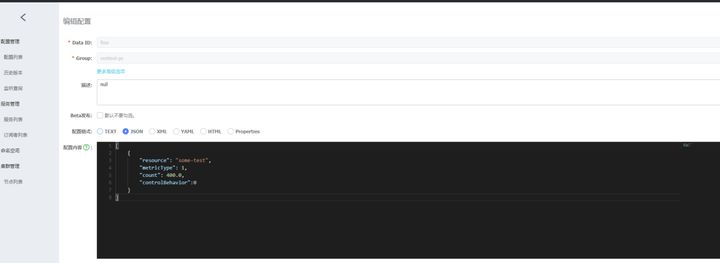您好,登录后才能下订单哦!
本篇文章给大家分享的是有关Sentinel-Go中怎么利用Nacos 实现外部动态数据源,小编觉得挺实用的,因此分享给大家学习,希望大家阅读完这篇文章后可以有所收获,话不多说,跟着小编一起来看看吧。
随着微服务的流行,服务和服务之间的稳定性变得越来越重要。Sentinel 以流量为切入点,从流量控制、熔断降级、系统负载保护等多个维度保护服务的稳定性。
Sentinel 具有以下特征:
丰富的应用场景:Sentinel 承接了阿里巴巴近 10 年的双十一大促流量的核心场景,例如秒杀(即突发流量控制在系统容量可以承受的范围)、消息削峰填谷、集群流量控制、实时熔断下游不可用应用等。
完备的实时监控:Sentinel 同时提供实时的监控功能。您可以在控制台中看到接入应用的单台机器秒级数据,甚至 500 台以下规模的集群的汇总运行情况。
广泛的开源生态:Sentinel 提供开箱即用的与其它开源框架/库的整合模块,例如与 Spring Cloud、Dubbo、gRPC 的整合。您只需要引入相应的依赖并进行简单的配置即可快速地接入 Sentinel。
完善的 SPI 扩展点:Sentinel 提供简单易用、完善的 SPI 扩展接口。您可以通过实现扩展接口来快速地定制逻辑。例如定制规则管理、适配动态数据源等。
2012年,Sentinel 诞生,主要功能为入口流量控制。
2013-2017年,Sentinel 在阿里巴巴集团内部迅速发展,成为基础技术模块,覆盖了所有的核心场景。Sentinel 也因此积累了大量的流量归整场景以及生产实践。
2018年,Sentinel 开源,并持续演进。
2019年,Sentinel 在多语言扩展的方向上逐步探索,陆续推出 C++ 原生版本、Envoy 集群流量控制支持。
Nacos是一个更易于构建云原生应用的动态服务发现、配置管理和服务管理的平台,Nacos脱胎于阿里巴巴内部的ConfigServer和Diamond,是它们的开源实现。经历过双十一流量峰值和阿里巴巴经济体超大规模容量的考验,沉淀了阿里巴巴软负载团队在这个领域十年的经验,在稳定性和功能性上都有很好的保障。

(Sentinel-Go集成Nacos动态数据源架构)
目前 Sentinel 内部的限流、熔断等策略都是基于规则来实现的,提供动态数据源扩展的目的,就是希望将规则数据的加载以及更新操作通过一些配置中心中间件(比如 nacos,etcd,conful,等等)来实现动态更新。
未集成nacos时 规则定义在代码内部,没有使用外部数据源。
go get http://github.com/alibaba/sentinel-golang
使用 Sentinel 主要分为以下几步:
对 Sentinel 进行相关配置并进行初始化
埋点(定义资源)
配置规则
package main
import (
"fmt"
"log"
"math/rand"
"time"
sentinel "github.com/alibaba/sentinel-golang/api"
"github.com/alibaba/sentinel-golang/core/base"
"github.com/alibaba/sentinel-golang/core/flow"
"github.com/alibaba/sentinel-golang/util"
)
func main() {
// We should initialize Sentinel first.
err := sentinel.InitDefault()
if err != nil {
log.Fatalf("Unexpected error: %+v", err)
}
_, err = flow.LoadRules([]*flow.FlowRule{
{
Resource: "some-test",
MetricType: flow.QPS,
Count: 10,
ControlBehavior: flow.Reject,
},
})
if err != nil {
log.Fatalf("Unexpected error: %+v", err)
return
}
ch := make(chan struct{})
for i := 0; i < 10; i++ {
go func() {
for {
e, b := sentinel.Entry("some-test", sentinel.WithTrafficType(base.Inbound))
if b != nil {
// Blocked. We could get the block reason from the BlockError.
time.Sleep(time.Duration(rand.Uint64()%10) * time.Millisecond)
} else {
// Passed, wrap the logic here.
fmt.Println(util.CurrentTimeMillis(), "passed")
time.Sleep(time.Duration(rand.Uint64()%10) * time.Millisecond)
// Be sure the entry is exited finally.
e.Exit()
}
}
}()
}
<-ch
}Sentinel-Go集成Nacos实现外部动态数据源功能.
您可以在Nacos的release notes及博客中找到每个版本支持的功能的介绍,当前推荐的稳定版本为1.3.1。
Nacos 依赖 Java 环境来运行。如果您是从代码开始构建并运行Nacos,还需要为此配置 Maven环境,请确保是在以下版本环境中安装使用:
64 bit OS,支持 Linux/Unix/Mac/Windows,推荐选用 Linux/Unix/Mac。
64 bit JDK 1.8+;下载 & 配置。
Maven 3.2.x+;下载 & 配置。
你可以通过源码和发行包两种方式来获取 Nacos。
从 Github 上下载源码方式
git clone https://github.com/alibaba/nacos.git cd nacos/ mvn -Prelease-nacos -Dmaven.test.skip=true clean install -U ls -al distribution/target/ // change the $version to your actual path cd distribution/target/nacos-server-$version/nacos/bin
下载编译后压缩包方式
您可以从 最新稳定版本 下载 nacos-server-$version.zip 包。
unzip nacos-server-$version.zip 或者 tar -xvf nacos-server-$version.tar.gz cd nacos/bin
Linux/Unix/Mac
启动命令(standalone代表着单机模式运行,非集群模式):
sh startup.sh -m standalone
如果您使用的是ubuntu系统,或者运行脚本报错提示[[符号找不到,可尝试如下运行:
bash startup.sh -m standalone
Windows
启动命令:
cmd startup.cmd
或者双击startup.cmd运行文件。
部署成功访问 http://127.0.0.1:8848/nacos
用户名/密码:nacos/nacos
登录到nacos web
在配置管理中,新建配置
输入dataId,group(dataId,group 创建时可以自定义,本文创建的dataId=flow,group=sentinel-go)
将数据源样例粘贴到配置内容中。
此样例是流量控制的Demo配置。当流量并发数大于100直接拒绝。
[
{
"resource": "some-test",
"metricType": 1,
"count": 100.0,
"controlBehavior":0
}
]创建完成后,在nacos配置列表中可以看到对应的限流配置。

版本
sentinel-golang 版本使用0.6.0,nacos-sdk-go 使用1.0.0
go.mod
module sentinel-go-nacos-example go 1.13 require ( github.com/alibaba/sentinel-golang v0.6.0 github.com/nacos-group/nacos-sdk-go v1.0.0 )
main.go
package main
import (
"fmt"
"math/rand"
"sync/atomic"
"time"
sentinel "github.com/alibaba/sentinel-golang/api"
"github.com/alibaba/sentinel-golang/core/base"
"github.com/alibaba/sentinel-golang/ext/datasource/nacos"
"github.com/alibaba/sentinel-golang/util"
"github.com/nacos-group/nacos-sdk-go/clients"
"github.com/alibaba/sentinel-golang/ext/datasource"
"github.com/nacos-group/nacos-sdk-go/common/constant"
)
type Counter struct {
pass *int64
block *int64
total *int64
}
func main() {
//流量计数器,为了流控打印日志更直观,和集成nacos数据源无关。
counter := Counter{pass: new(int64), block: new(int64), total: new(int64)}
//nacos server地址
sc := []constant.ServerConfig{
{
ContextPath: "/nacos",
Port: 8848,
IpAddr: "127.0.0.1",
},
}
//nacos client 相关参数配置,具体配置可参考https://github.com/nacos-group/nacos-sdk-go
cc := constant.ClientConfig{
TimeoutMs: 5000,
}
//生成nacos config client(配置中心客户端)
client, err := clients.CreateConfigClient(map[string]interface{}{
"serverConfigs": sc,
"clientConfig": cc,
})
if err != nil {
fmt.Printf("Fail to create client, err: %+v", err)
return
}
//注册流控规则Handler
h := datasource.NewFlowRulesHandler(datasource.FlowRuleJsonArrayParser)
//创建NacosDataSource数据源
//sentinel-go 对应在nacos中创建配置文件的group
//flow 对应在nacos中创建配置文件的dataId
nds, err := nacos.NewNacosDataSource(client, "sentinel-go", "flow", h)
if err != nil {
fmt.Printf("Fail to create nacos data source client, err: %+v", err)
return
}
//nacos数据源初始化
err = nds.Initialize()
if err != nil {
fmt.Printf("Fail to initialize nacos data source client, err: %+v", err)
return
}
//启动统计
go timerTask(&counter)
//模拟流量
ch := make(chan struct{})
for i := 0; i < 10; i++ {
go func() {
for {
atomic.AddInt64(counter.total, 1)
//some-test 对应在nacos 流控配置文件中的resource
e, b := sentinel.Entry("some-test", sentinel.WithTrafficType(base.Inbound))
if b != nil {
atomic.AddInt64(counter.block, 1)
// Blocked. We could get the block reason from the BlockError.
time.Sleep(time.Duration(rand.Uint64()%10) * time.Millisecond)
} else {
atomic.AddInt64(counter.pass, 1)
time.Sleep(time.Duration(rand.Uint64()%10) * time.Millisecond)
// Be sure the entry is exited finally.
e.Exit()
}
}
}()
}
<-ch
}
//statistic print
func timerTask(counter *Counter) {
fmt.Println("begin to statistic!!!")
var (
oldTotal, oldPass, oldBlock int64
)
for {
time.Sleep(1 * time.Second)
globalTotal := atomic.LoadInt64(counter.total)
oneSecondTotal := globalTotal - oldTotal
oldTotal = globalTotal
globalPass := atomic.LoadInt64(counter.pass)
oneSecondPass := globalPass - oldPass
oldPass = globalPass
globalBlock := atomic.LoadInt64(counter.block)
oneSecondBlock := globalBlock - oldBlock
oldBlock = globalBlock
fmt.Println(util.CurrentTimeMillis()/1000, "total:", oneSecondTotal, " pass:", oneSecondPass, " block:", oneSecondBlock)
}
}
在项目启动过程中,在nacos中修改流控配置参数。将count 从100->400

可以看到打印了重新loadRule的日志,流量控制动态的由100->400

在sentinel-go中使用nacos作为外部动态数据源,只需要将原来声明Rule以及加载Rule的部分 变成从nacos数据源读取。
在本文中只介绍了流量控制的集成,熔断,warmup,热点参数的集成也是相同的,只要按需修改配置的内容即可
关键代码:
h := datasource.NewFlowRulesHandler(datasource.FlowRulesJsonConverter)
nds, err := nacos.NewNacosDataSource(client, "sentinel-go", "flow", h)
if err != nil {
fmt.Printf("Fail to create nacos data source client, err: %+v", err)
return
}
err = nds.Initialize()
if err != nil {
fmt.Printf("Fail to initialize nacos data source client, err: %+v", err)
return
}以上就是Sentinel-Go中怎么利用Nacos 实现外部动态数据源,小编相信有部分知识点可能是我们日常工作会见到或用到的。希望你能通过这篇文章学到更多知识。更多详情敬请关注亿速云行业资讯频道。
免责声明:本站发布的内容(图片、视频和文字)以原创、转载和分享为主,文章观点不代表本网站立场,如果涉及侵权请联系站长邮箱:is@yisu.com进行举报,并提供相关证据,一经查实,将立刻删除涉嫌侵权内容。